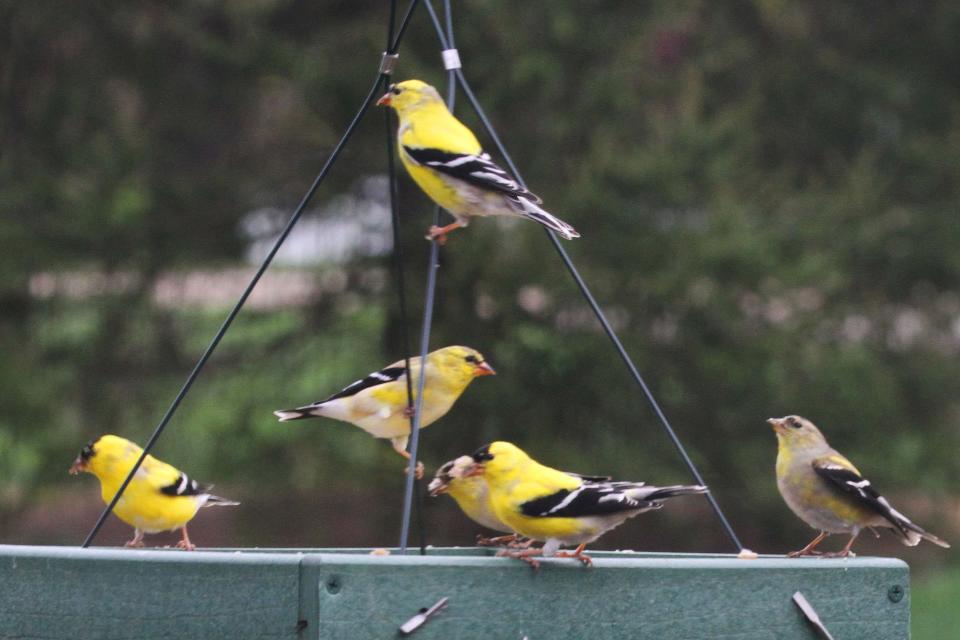A certain type of bird is emptying feeders at a dizzying pace this spring
Mobs of American goldfinches are emptying feeders at a record pace. Most backyard bird watchers acknowledge that they haven't seen anything like it.
Several weeks ago, the first big wave was made up of mostly males, virtually all in splotchy molting plumage. If it weren’t for the massive numbers and dizzying activity at feeders, they were so unlike lovely breeding males that they might have passed unnoticed.
Now, though, the spiffy male goldfinches wear their namesake bright gold breeding plumage with strikingly contrasting black caps and wings. Also now the current wave boasts more satin-olive females than males.
Of course, among songbirds, most males migrate ahead of females to garner the best breeding territories.
So what’s all this about migrating goldfinches? Don’t local feeders host these birds year-round? Yes, but they’re not necessarily the same goldfinches year-round. Here’s how that works:
The breeding range for American goldfinches extends almost halfway up through Canada. Given that goldfinches are 100 percent vegetarians, the inhospitable winter climate in central Canada offers them little sustenance. So they head south.
But the southern edge of goldfinches’ breeding range stops about midway through Georgia, barely creeping into Louisiana. That leaves a vast swath of fertile vegetation between there and the Gulf Coast. Many experts believe Canada-breeding goldfinches migrate to that rich feeding range, leapfrogging over us where resident goldfinches maintain territories. So we often see high numbers of goldfinches at feeders in both fall and spring.

This spring, through, surely makes history, at least among the backyard bird hosts reporting in. While I have only two seasons of “history” at my current residence, I know I never counted 83 goldfinches at, around, and under feeders at any one time anywhere I’ve lived.
And that was the case recently. Aside from that high number, counts never dropped below 28 during either wave. I’ve become a regular at the local bird-feed store where I check out with 20 pounds of black-oil sunflower seed hearts (sometimes called “chips”) twice a week. Shall I actually have to say I’m ready for bright little guys and gals to move on?
Do any stay? Of course. Our beloved goldfinches, however, are the very last songbirds to nest. Again, that vegetarian habit of their comes in to play. Since they are one of only two species of songbirds that do not feed their babies bugs (mourning doves are the other), they have to wait until plants bloom, produce seed, and the seed ripens in order to raise their single brood successfully.
And because they use the seed fluff from thistles to build their amazing little nests, that biological cycles has to play out, too.
So goldfinches may begin nesting as late as the end of July, maybe even August. After all, our resident goldfinches need not rush the nesting season since their babies won’t be making a long-distance journey to a winter range.
Birds of the World, the premier avian website, summarizes the goldfinch phenomenon this way: “The occurrence and extent of migration varies by sex, age, and latitude. Wintering flocks are nomadic, their movements closely tied to food supply.”
The website’s accompanying animated map shows area populations peak in April and September. When the mobs are gone, I’ll miss the action. Just not the seed bill.
For more information about birds and bird habitat, see Sharon Sorenson’s books How Birds Behave, Birds in the Yard Month by Month, and Planting Native to Attract Birds to Your Yard. Follow daily bird activity on Facebook at SharonSorensonBirdLady, or email her at chshsoren@gmail.com.
This article originally appeared on Evansville Courier & Press: How can I spot goldfinches at my bird feeder?

